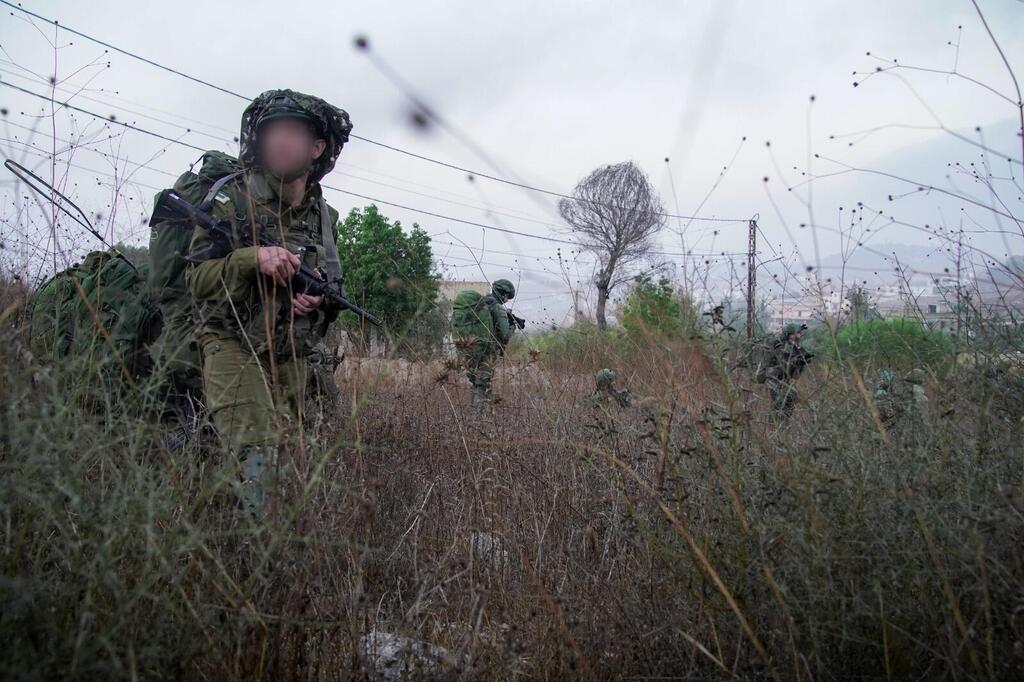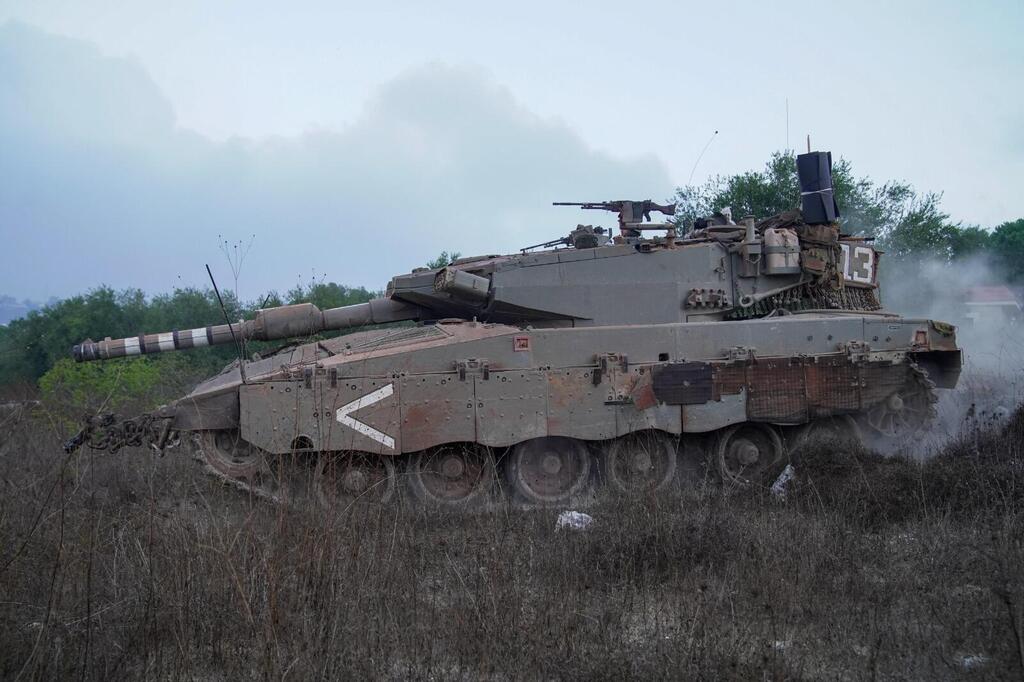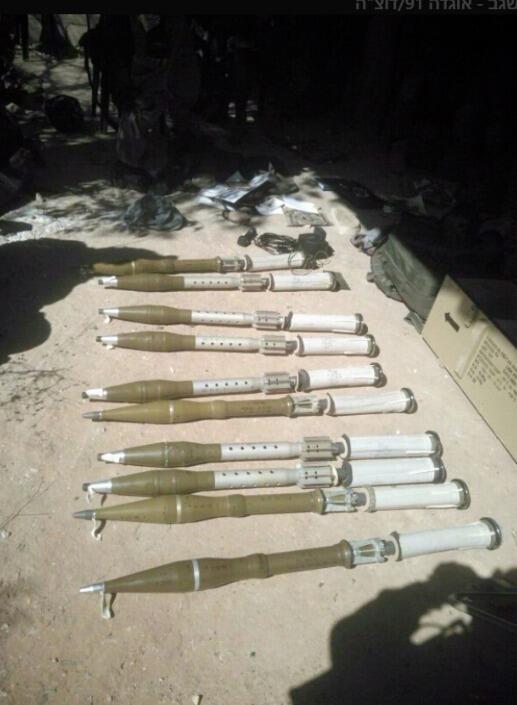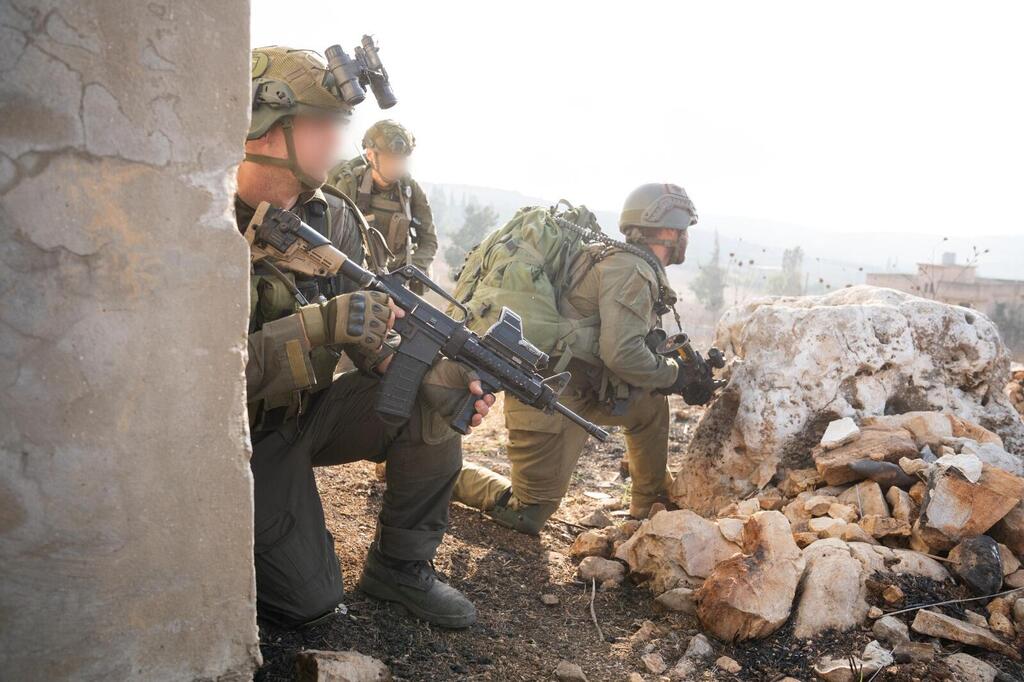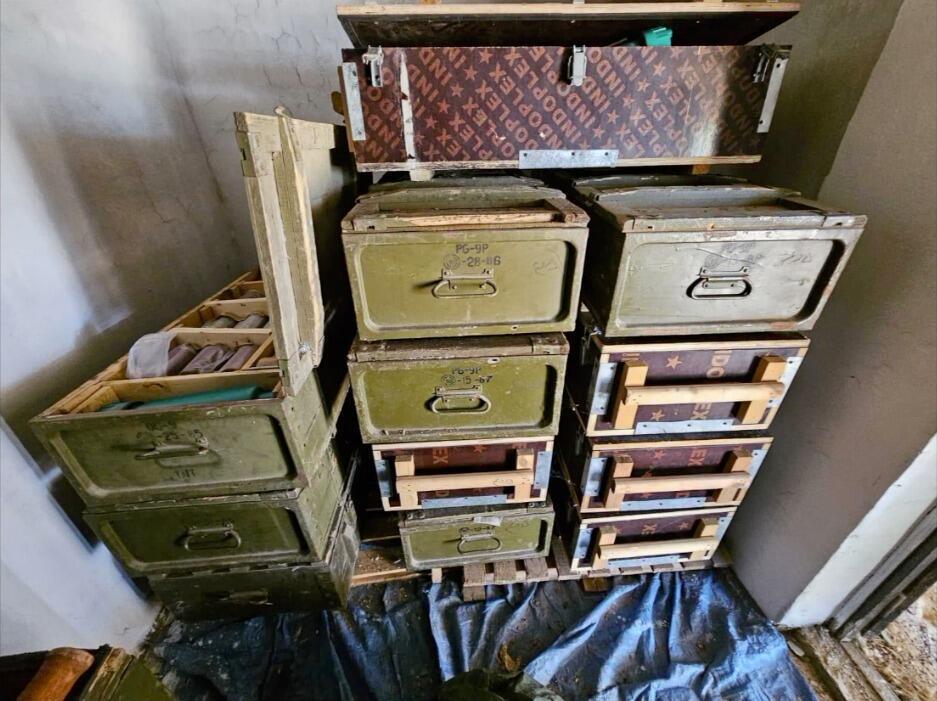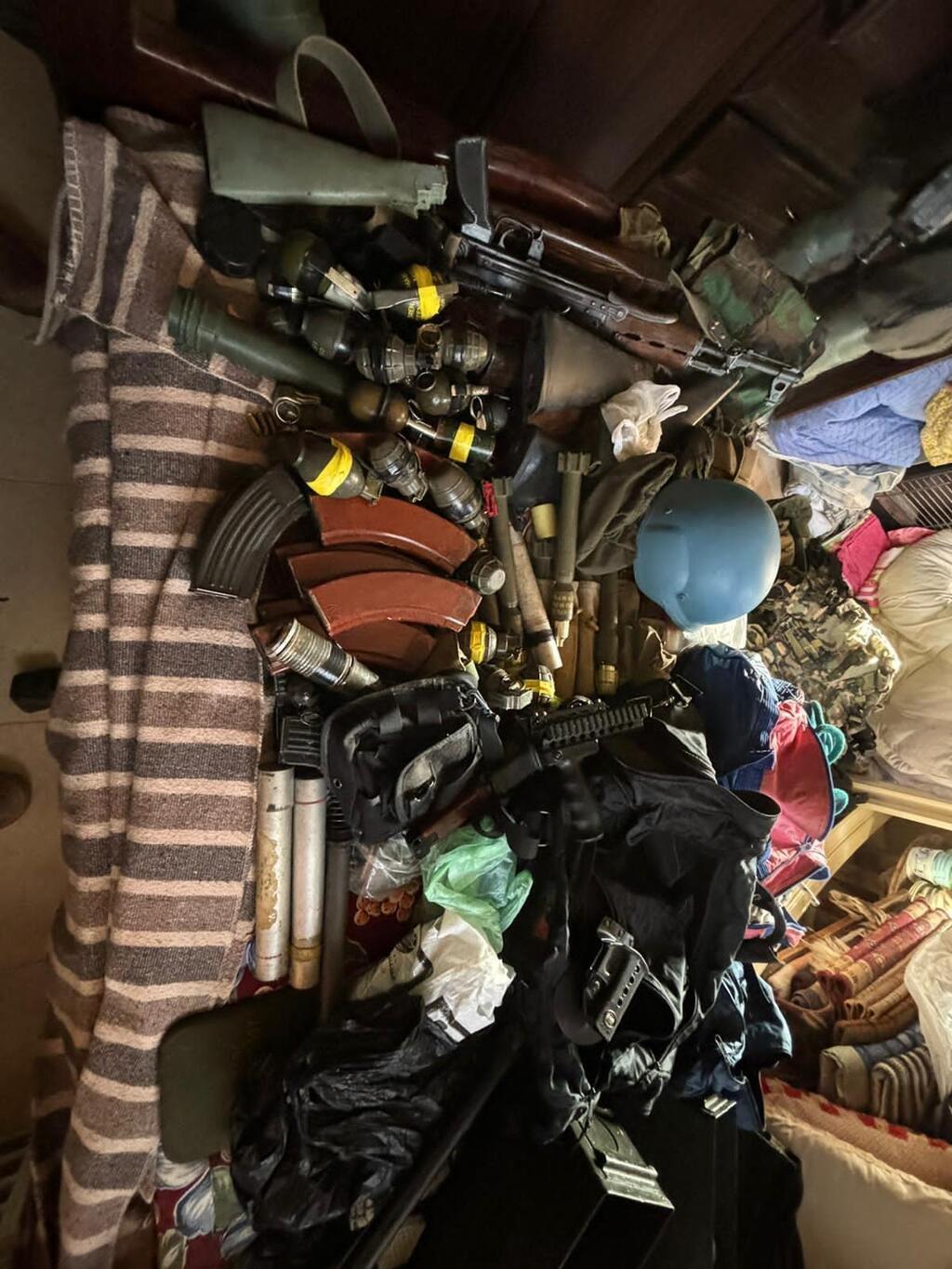Almost two weeks into the IDF's ground incursion into southern Lebanon, I accompanied the forces into the Shiite villages on Thursday.
Looking left out of the Hummer, I see the nearby Lebanese village. My first thoughts are that from such a distance, one mortar or anti-tank missile, and my chances of surviving are slim.
We’re still traveling along the Israeli side of the border along a rickety road, once used for patrols. A thin fence, full of sensors, separates us from Lebanese territory, and I’m thinking about Hezbollah's elite Radwan Force, which this fence was supposed to delay, or at least warn us about, minutes before reaching the nearby Israeli community.
10 View gallery


Ynet war correspondent Ron Ben-Yishai with IDF forces in southern Lebanon
(Photo: Ron Ben-Yishai)
I can’t detail the location or the village we’re going to as Hezbollah reads, watches and listens to everything published by Israeli media, and an explosive-laden drone may well find its way here tomorrow. It’s no longer theoretical. This is reality, but it’s going to change.
While traveling, we see the houses at the front of the village, out of which short-range rockets and anti-tank missiles have been launched over the past year. The Israeli Air Force (IAF) hit them very well indeed.
The IDF breaks through the border fence, and we start bouncing along a path that had been used by Lebanese farmers tending the terrace orchards. The old and familiar scent of Lebanon at the summer’s end kicks in: sage, thorns, yellow grass and a lot of burning. Over the past year, no Israeli has set foot here on our side of the border, less still on the Lebanese side.
These villages served as Hezbollah’s firing bases. But no more. We’re driving along here in open Hummers because the 91st Division has pushed Hezbollah’s anti-tank missiles back a few ridges north and west of here. Even if they were to put their mind to it, they couldn’t target us directly as they could have done up to only a few days ago.
The 91st Division, however, is still fighting in the villages near the border, and cleansing one house after the other. Every now and then, you hear an explosion, followed by a long round of gunfire, followed by silence.
The ambushes set up by the IDF along the border fence lead us, out of Hezbollah’s line of vision, to a bone-racking windy route straight into the village. To our left, a reserve duty unit takes cover in a half-ruined house. To our right, there’s an excavator with a huge arm breaking the walls of a rather stubborn house built of concrete, natural rocks and hard dolomite, the most plentiful rock around here: The “Dahieh doctrine” in action.
Thousands of Radwan fighters awaited the order to storm into Israel
A Radwan Force numbering 4,000–6,000 men was supposed to include six brigades and 16 battalions intending to invade Israel all at once along six routes. The plan was for Radwan operatives to live in the villages and dug-out compounds in the tangled terrain, waiting for the day the order would be given. They would then come out of the villages and the thicket and, under the cover of rocket and artillery fire, break through the fence and storm Israeli civilian communities and IDF outposts.
The plan was for the Radwan force and Hezbollah men to ordinarily walk around unarmed, as innocent villagers, and then, when the order was given, descend to the subterranean bunkers in the thicket on the village outskirts, come out with the equipment and charge toward Israel. The equipment prepared for that day includes vests, AK-47s, helmets and explosives to break through fences and smash walls.
Radwan Forces would cross the Israeli border following fire from forces stationed on the front line by the Israeli border covering them. Hezbollah leader Hassan Nasrallah was so sure he could implement the element of surprise that he didn’t even bother concealing the plan’s outline.
Brig. Gen. Shai Kleper, 91st Division commander, whom we accompanied for our tour in southern Lebanon, shows us an arsenal prepared for the day the order is given. “This storehouse serves Hezbollah and Radwan attack forces who come here and equip themselves,” he says.
“Here, you can see hundreds of vests packed full of cartridges alongside sniper rifles, AK-47s and machine guns. Here, at the side, there are mortars, here landmine explosives and here you see bags of RPDs, Dragunovs, Steyrs and hand grenades.
10 View gallery


Hundreds of protective vests found in southern Lebanon border villages
(Photo: IDF Spokesperson's Unit)
It means that an operative leaves Bekaa in jeans and sandals, gets here, gets his combat equipment, a map, the plan he’s already prepared for, and with it knows how to get in. That’s this line. The next line is where Hezbollah deployed rocket launchers aimed toward Israeli territory. They’re deployed here, in apparently civilian orchards; this, apparently civilian, village is, in fact, a military village used as a springboard into the territory of the State of Israel.”
Thursday evening, the IDF revealed some details regarding the weapons found so far by the 91st Division in southern Lebanon, which we accompanied, that raided various areas, destroyed Hezbollah terror infrastructure and weapons and conducted face-to-face battles with terrorists.
“The 3rd Brigade’s combat team found 800 military vests and hundreds of weapons including grenades, explosive devices and AK-47s," the army said. "The 8th Brigade combat team found crates of weapons in civilian homes, including magazines and long-range Kornet anti-tank missile launchers aimed at the communities in the Galilee and the surrounding area and dozens of ready-for-launch missiles.”
We have to be honest: Had Nasrallah implemented his plan on October 8, 2023, the day following the Hamas attack, it would have likely been a catastrophe. But the IDF reservists rushed here, some without even being called up, positioned themselves here to defend the border. Now, those same reserve duty units, the 228th Brigade, ex-Nahal men, the 769th Brigade and ex-Golani men, along with further brigades are here for defensive (offensive?) purposes.
10 View gallery


Vast arsenal found in southern Lebanon border villages
(Photo: IDF Spokesperson's Unit)
This Sunday, these same brigades crossed into southern Lebanon on foot via crossings, pathways, and unanticipated routes. Before entering the villages, however, the 91st Division elite vanguard at the front, commanded by Brig. Gen. Kleper, seized controlling ridges miles away to neutralize the anti-tank missile threat. Hezbollah was relying on these missiles and, in his last speech, Nasrallah even mocked IDF forces, inviting them to come in to taste Hezbollah’s missiles.
But the Northern Command, with very few exceptions, has surprisingly dismissed Hezbollah’s ability to make use of its key weapons. Simply because the IAF has preemptively taken out anti-tank missile launchers and anti-tank fire positions, with frontline ground forces quickly taking control of them. The main forces then entered the villages accompanied by tanks.
Hezbollah homes packed with weapons and ammunition
We walk among the houses. Here and there, we hear forces cleanse a house. Thursday afternoon, the day before the eve of Yom Kippur, there were no altercations. None of our forces were hurt, and most of the explosions were those of houses blown up by the IDF, in which Hezbollah and Radwan forces operatives were staying.
We’re now in the village. Bint Jbeil is not far from here. The little mountain village that had turned into a large, flourishing community, has mostly been reduced to ruins. During the War of Attrition in the 1970s and the Second Lebanon War a decade later, when I was here, the enemy were Palestinian terrorists, most of whom fled after the first round of gunfire, or surrendered to our forces without a fight. This time, the enemy’s different.
“Yesterday, we had an altercation,” says 29-year-old Alaa from Usfiya, who has served over 300 days in reserve duty since October 7. “We got close to here, and they suddenly started shooting at us from all directions. At first, we thought it was friendly fire, but we soon realized that terrorists were firing at us from those two houses,” he added, pointing at a burned-out house with walls perforated by bullet holes and another house with a few destroyed walls beside it.
“In addition to shooting at us, they also used explosive devices, but we didn’t fall into the trap. We had eight wounded, not seriously, and we managed to kill the terrorists who ambushed us from the houses.”
Alaa says that serving for so long in reserve duty isn’t hard for him. "We haven’t had so many altercations. They’re like mice, trying to run away underground, attacking us with all kinds of devices, but we’re crushing them,” he says.
Shalev, 22, from Ashkelon has also been serving on the northern border for many months. “We’ve been here both for defense and offense. The offensive part feels much more important. We’re destroying the enemy” he says.
Hezbollah is still in these little villages, intermittently taking the IDF by surprise. The extensive experience garnered during the fighting in Gaza plays a crucial role. The work put in by the Northern Command, the IAF and special forces who operated here covertly before the ground operation, made their message clear: Most of the Radwan Force was pushed north, some even beyond the Litani River. This likely explains the relatively meager resistance and the rather low number of casualties, that were not severe, suffered by the four divisions dealing with these villages.
Even before the ground operation in southern Lebanon, the IDF worked extensively to prepare the area. “We peeled Hezbollah and cooked it very slowly in a pot, here in this area, from Dahieh all the way to Bekaa,” says IDF spokesperson Rear Admiral Daniel Hagari.
“We gradually eliminated the commanders of the main units. We peeled away their capabilities. Thousands of terrorists who should have been here now, have been repelled, killed.”
Hagari says, that now, that we’re “after a strong aerial campaign and have assassinated the senior command, we’re comprehensively dismantling the infrastructure and weapons that Hezbollah had prepared here to conquer the Galilee.”
“Even, as you stand here now, the threat is still present,” he says. “There’s the threat of mortars and anti-tank missiles. We’re not in a sterile environment. Terrorists are lurking here too. We’re cleansing. It’s not sterile – but this isn’t what should have been here.
The 98th Division's limited operations in southern Lebanon
(IDF)
"The element of surprise afflicted on the enemy stems from an orderly process conducted by the Northern Command and the IDF over the past year: An orderly and systematic degradation of Hezbollah’s command capabilities, repelling the enemy far away from here, eliminating important cells, while working on Hezbollah’s strategic capabilities and going in with a ground operation after training, at a time that the enemy is in an inferior state. This is the operation that was built and this is what we’re doing.
“We’re going house to house finding piles of Radwan Forces’ personal equipment, or cannons pointing at Israel lying around the yard. We see flimsy electric wires leading from the houses to rocket launchers with mortar barrels positioned on the edges of the orchards, and obviously, above all, dozens of Kornet anti-tank missiles, as well as older models.”
Only when you see this vast arsenal and notice the up-to-date night vision equipment lying in the corner of the room do you realize that there was an army here – a terrorist army ready to charge at our communities. I prefer not to think about what would have happened if the IDF, primarily the reservists, hadn’t rushed to position themselves on the defense lines in such a way that made Nasrallah and his field commanders not want to try us. Now, Lebanon is living the Gaza experience.
“How long have you been on reserve duty?” I ask Lt. Avi Goldberg from Jerusalem. “Three hundred days, I think. Maybe more,” he says without batting an eye. “We’ll be here and do the work for as long as it takes. We have to bring the residents of the north back to their homes.”
I try testing him saying, “I’m hearing that cliché over and over. Do you really mean it?” This provocation doesn’t even make him blink. “No. That’s what I, and everyone you see here around you, thinks exactly. It’s not a cliché. It’s reality. This is what we’re supposed to do and this is what we’ll do and we won’t leave here until we’ve done it,” he asserts.
I’m not giving up. I go up to one of the soldiers and ask him the same question. Believe it or not, I get the exact same answer, word for word, despite this reservist being a father of four nearing 40.
Yaniv Berliner, a reservist living on Kibbutz Or Haner near the Gaza border, has served a whole year in the reserves. “Only a few days ago, a year passed since that horrific day. I have friends, acquaintances and relatives still in captivity. I hope that what we’re doing here will help bring them back home as quickly as possible,” he says.
“We’re doing everything we can, and we’ll serve as long as we need, to genuinely restore security to the country and its borders. There are reservists here risking their lives day and night, 24/7. I hope that everything we’re doing here will be worth it.”
For now, it seems to be working, and it looks like without cleansing this strip of the vast quantity of weapons, the infrastructure for launching attacks into Israel and the arsenals above and below ground, no one living on the northern border will be going back home. Moreover, the State of Israel won’t be able to let them back before totally cleansing the sector - not only due to the absent sense of security – but also due to security itself.
Get the Ynetnews app on your smartphone:



